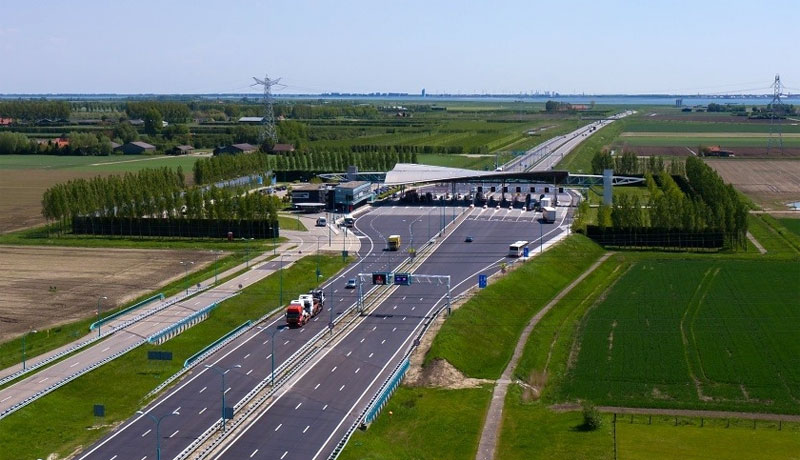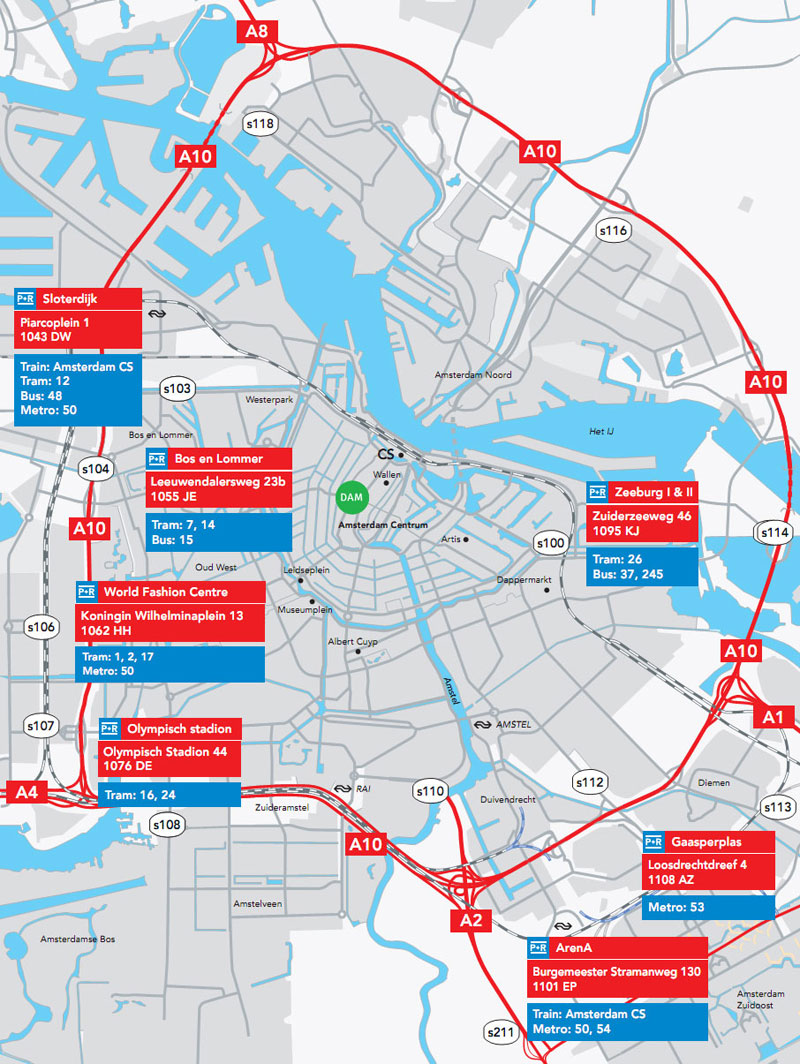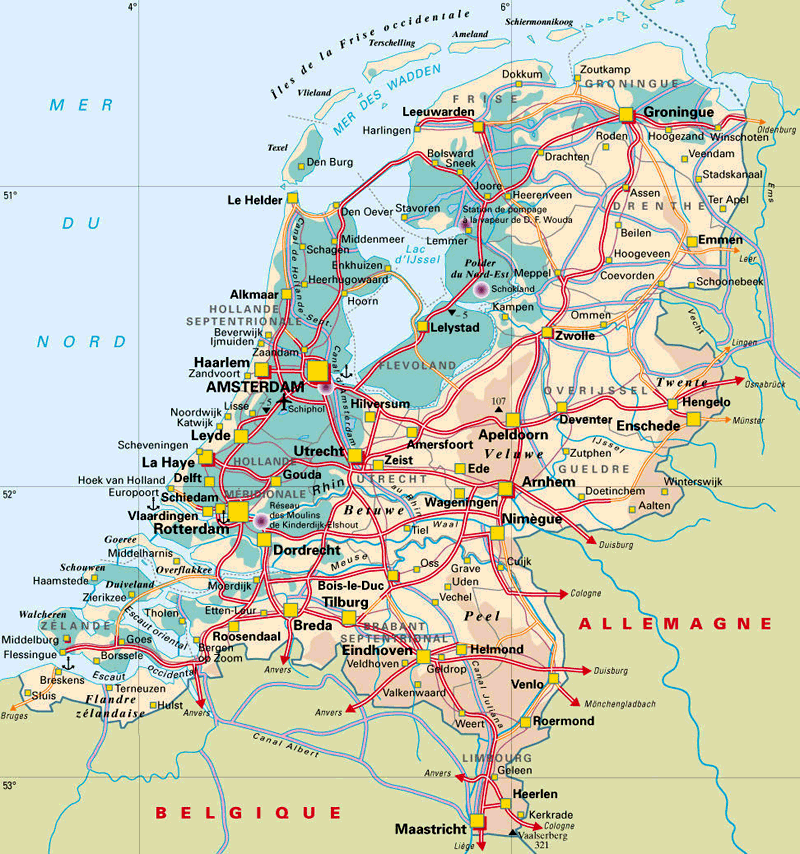Driving in Netherlands
The total length of roadways of Netherlands is 139,295 km. All of them are paved. Length of motorways - 2,808 km.
ContentsToll roads
There is no toll road in the Netherlands. Only travel through some tunnels is subject to payment.
Special toll
Westerschelde Tunnel
The Westerschelde tunnel connects Terneuzen (in Zeeland Flanders) and Goes (in South Beveland). The length of the tunnel is 6.6 km. All vehicles that reach a speed of 80 km/h can use the Westerschelde tunnel. Safety was a top priority during the construction of the tunnel, making the Westerschelde tunnel one of the safest in Europe.

Tunnel location: Google Maps, Google Earth.
Toll rate at 2023:| VEHICLE | TARIFF | |
|---|---|---|
| Motorcycle | € 5.00 | |
| Vehicle up to 6 m long and up to 3 m high (cars, minibuses without a trailer) |
€ 5.00 | |
| Vehicle more than 6 m long and up to 3 m high (cars, minibuses with a trailer) |
€ 7.45 | |
| Vehicle up to 12 m long and more than 3 m high (motorhomes, buses) |
€ 18.20 |
The toll station is located on the north side of the tunnel. Payment for the tunnel can be made in cash (in euros) or by credit card (American Express, Visa, MasterCard, DKV, Routex and EuroShell).
Kiltunnel
The tunnel is located in Dordrecht (South Holland). The total length of the tunnel is 901 m. The length of the closed part of the tunnel is 406 m.

Tunnel location: Google Maps, Google Earth.
Toll rate at 2023:| VEHICLE | TARIFF | |
|---|---|---|
| Vehicle up to 2.3 m high | € 2.00 | |
| Vehicle with a height of more than 2.3 m | € 5.00 |
Pedestrians and cyclists can also use the tunnel.
Parking in Netherlands
Parking is not allowed near black and white or yellow curbs. Incorrectly parked vehicles can be towed to a fine parking lot (fine from € 90) or their wheel is blocked. Parking in areas designated for the disabled is punishable by a fine of € 360.
P+R — Parking
There is an acute shortage of parking spaces in Amsterdam and other major cities. In order to reduce congestion, a system of intercept parking ("Park + Ride") has been introduced in many cities. The driver parks in a specially organized place, outside or on the outskirts of the city, and then gets to the city center by public transport.
From February 1, 2014, the following tariffs have been set for P+R parking:
- parking on weekdays until 10:00 am - € 8 for the first 24 hours, and then € 1 for every next 24 hours;
- parking on weekdays after 10:00 am - € 1 for 24 hours;
- on Saturday and Sunday - € 1 for 24 hours
The cost of the GVB card is added to the parking price:
- for 1 person: € 5
- for 2 persons: € 5
- for 3 persons: € 5.90
- for 4 persons: € 6.80
- for 5 persons: € 7.70
Below is a map of P+R parking lots in Amsterdam.

All parking lots are open 24 hours a day, 7 days a week, except for P+R Bos en Lommer (from 7 am to 10 pm). All parking lots are guarded, but it is not recommended to leave valuables in the salon.
P-Zone parking
Almost all parking in cities is paid. In such parking lots (marked with the appropriate sign "P-Zone") purchase parking tickets. Parking tickets are sold in special vending machines (usually gray or yellow) on the side of the road.
The parking ticket must be placed on the dashboard under the windshield. The absence of such a ticket can lead to the fact that the parking police will block the wheel of the car and issue a fine.
Blue Zone parking
To park in such a parking lot, you need a parking disc with a time stamp. These discs can be purchased from auto club offices, tobacco shops and police stations.
Map of Netherlands roads

Buy a Benelux Road Map on Amazon
Road rules in Netherlands
Speed limits

Standard speed limits in France (unless otherwise indicated on the signs).
Cars (to 3.5 tons) and motorcycles:- built-up areas - 50 km/h
- outside built-up areas - 80 km/h
- expressway - 100 km/h
- motorway - 130 km/h
- built-up areas - 50 km/h
- outside built-up areas - 80 km/h
- expressway - 90 km/h
- motorway - 90 km/h
- built-up areas - 50 km/h
- outside built-up areas - 80 km/h
- expressway - 80 km/h
- motorway - 80 km/h
It is forbidden to drive vehicles on motorways whose speed does not exceed 60 km/h in technical specifications. Fine - € 360.
The current maximum speed limits on the roads of European countries for cars.
Speed cameras
There are many fixed speed cameras in the Netherlands that take pictures of cars that are not following the speed limits.
Also on 12 main motorways there are systems for measuring average speed over long distances. If the average speed is higher than the maximum allowed, the driver will receive a violation penalty.
Location of speed cameras in Dutch.
Experiment to increase the speed to 130 km/h
Since March 1, 2011, on some sections of motorways, the maximum speed has been increased to 130 km/h. During the experiment, the impact on infrastructure, traffic safety and the environment was studied.
Sections where the speed was increased to 130 km/h:
- A7 Wognum – Zurich
- A6 Almere Buiten-Oost – Joure
- A16 Moerdijk – Breda
- A2 Everdingen – Deil
- A17 Moerdijk – Bergen op Zoom
- A58 Bergen op Zoom – Vlissingen
- A32 Steenwijk – Heerenveen
- A37 Hoogeveen – Klazienaveen
Based on the results of the experiment, the government decided to establish from 1 September 2012 the upper speed limit on all motorways - 130 km/h. Exceptions are sections of motorways where this cannot be done due to negative environmental or road safety impacts.
The total length of motorways subject to the new speed limits is about 1,400 km (over 60% of all Dutch motorways).
On 900 km of motorways, the new restrictions will be in effect around the clock. And in the rest of the sections, the speed limit will be adjusted dynamically and applied whenever the traffic situation allows.
In addition, since July 1, 2012, the maximum speed on motorways near large cities has been increased from 80 km/h to 100 km/h.
The map below shows the motorways in the Netherlands with their speed limit.

List of motorways with the maximum speed in the Netherlands as of 23/06/2017 (278 Кб)
Alcohol
The maximum permitted level of alcohol in the bloodstream is 0.5 ‰.
If the level of alcohol in the bloodstream exceeds the allowable, a fine will be imposed:
- from 0.51 ‰ to 0.80 ‰ - € 325
- from 0.81 ‰ to 1.00 ‰ - € 425
- from 1.01 ‰ to 1.15 ‰ - € 550
- from 1.16 ‰ to 1.30 ‰ - € 650
- above 1.30 ‰ - till € the case will considered in court
For drivers whose driving experience does not exceed 5 years, as well as for moped drivers not older than 24 years, the maximum permissible blood alcohol level is 0.2 ‰.
If the blood alcohol level of such drivers is in the range of 0.21 ‰ up to 0.5 ‰, then the fine will be € 325.
The maximum permitted alcohol limit for drivers in European countries.
Dipped headlights
Dipped headlights is not required when driving in the daytime. Dipped headlights should be turned on in poor visibility conditions.
Fog lights may only be used if weather conditions require it. The front fog lights can be turned on in fog, snow or rain, i.e. when visibility is severely limited.
Rear fog lights can only be used in fog or snow when visibility is less than 50 meters. Fog lights should not be used during heavy rain.
Fine — € 120.
In which European countries is the use dipped headlights in daytime mandatory?
Children in cars
Children under 18 years of age and less than 135 cm tall may only travel when using suitable child restraint systems appropriate for their weight.
Children under 3 years old can only be transported in special child restraints. Child seats must comply with European safety requirements ECE R44 / 04.
Fine — € 130.
Seat belts
Seat belts is mandatory for both front and rear passengers.
Fine — € 130.
Mobile phone
The use of a mobile phone while driving is restricted to use of a hands-free device.
Fine — € 230.
Mobile phone while drivig in Europe
Penalties for using mobile phone while driving in Europian countries.
Window Tinting
The degree of light transmission of the windshield must be at least 75%, the front side windows must be at least 70%.
For rear windows, the degree of light transmission is not regulated, provided that the vehicle is equipped with a rear-view mirror on the side opposite to the driver.
Fine — € 230.
Fines
Fines can be paid directly to the police officer on the spot of the violation. In the case of illegal parking, the police can impose a fine on the spot or tow the car to a parking fine.
Traffic fines in Netherlands:| Violation | Fine (EUR) |
|---|---|
| Driving on the left lane with a free right on the road with two lanes in the same direction | € 220 |
| Frequent involuntary lane changes | € 220 |
| Traffic light violations | € 220 |
| Failure to signal before turning or changing lanes | € 90 |
| Using a sound signal for no objective reason | € 90 |
| Unreadable license plates | € 45 |
| Faulty wipers | € 120 |
| Overtaking violation | € 220 |
The following tolerances apply when measuring speed:
- Till 100 km/h — 3 km/h of measured speed
- Above 100 km/h — 3% of measured speed
This means that the lower limit of fines on most roads starts with a speeding of 4 km/h. Only on motorways where the speed of 130 km/h is allowed, there is no minimum border, and fines start with a speeding of 1 km/h.
The table of speeding fines in the Netherlands (EUR):| Speeding | ||||
|---|---|---|---|---|
| till 3 km/h | ---- | ---- | ---- | € 11 – 19 |
| 4 - 10 km/h | € 43 – 98 | € 26 – 66 | € 23 – 62 | € 23 – 58 |
| 11 - 15 km/h | € 124 – 170 | € 89 – 124 | € 84 – 119 | € 80 – 110 |
| 16 - 20 km/h | € 182 – 236 | € 133 – 176 | € 127 – 168 | € 118 – 158 |
| 21 - 25 km/h | € 251 – 315 | € 188 – 238 | € 178 – 225 | € 169 – 210 |
| 26 - 30 km/h | € 332 – 390 | € 251 – 308 | € 238 – 293 | € 222 – 269 |
| 31 - 35 km/h | Court | Court | Court | € 282 – 337 |
| 36 - 40 km/h | Court | Court | Court | € 351 – 390 |
If the speed exceeds 30 km/h (over 40 km/h on the motorway), the case will be considered in court. If the speed exceeds 50 km/h, the driver will be automatically revoked.
Speeding fines in the Netherlands are higher for motorcyclists than for motorists.
Useful information
Fuel prices
В Нидерландах доступен неэтилированный бензин (Ongelood 95 и 98) и дизельное топливо. Газовые заправки (LPG) имеются в большом количестве.
Национальная средняя розничная цена (GLA) устанавливается ежедневно на основе средних национальных розничных цен пяти крупнейших нефтяных компаний (Shell, BP, Esso, Texaco и Total).
Average prices for all types of fuel at 2025-07-08:
- Euro95 — € 2.118
- Super — € 2.299
- Diesel — € 1.884
- LPG — € 1.053
Trends gasoline prices in Netherlands for last years.
In the country, it is allowed to carry gasoline in cans in a car.
Changes from the previous period are shown. Update every two weeks.
Emergency phone numbers
- European emergency number - 112
Compulsory to carry in car
In the Netherlands, there are no requirements for equipment that must be carried in a car.
Обязательное оборудование в автомобиле в Европе
Требования к оборудованию, которое обязательно должно находиться в автомобиле в разных странах Европы.
Winter equipment
Winter tires
The use of winter tires in Netherlands is optional.
Spiked tires
Spike tires are prohibited.
Snow chains
The use of snow chains is prohibited.
Зимнее оборудование автомобиля в Европе
Требования к использованию зимних и ошипованных шин в разных странах Европы.
Optional equipment and other rules
Warning triangle - must be used in case of an accident or stop. Therefore, although it is not on the list of mandatory equipment, it is better to have it in the car.
First aid kit.
Reflective jacket.
The use of radar detectors is prohibited. For its use, a fine of € 420 with the confiscation of the device.
On the video you can see Lake Markermeer road (N302) (more video at our YouTube channel).